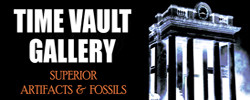Product Description
SEE MORE ANCIENT NEAR EASTERN ARTIFACTS
With the finest bi-colored patina and exceptionally rare engraved decorations throughout, this large and heavy functional cast mace head is undoubtedly a weapon that was reserved for a commanding warrior or nobleman of the highest social class. It is attributed to the ancient Persian Empire during the Islamic Golden Age, and dates from the 8th to 13th century A.D.. We have had the pleasure of offering some of the rarest and finest ancient militaria over the decades and this MUSEUM-CLASS mace will always rank as one of the finest pieces in our catalog. Not only does it feature classic Islamic floral design engraving throughout, it was made with a multi-color feature in ancient times to further embellish this mace head with as much beauty as possible. The mace was cast from arsenical copper and then surface-enriched with additional arsenic to create a bi-color effect that has now patinated black and red. In ancient times, it would have originally been a gold hue transitioning to red at the non-treated copper base.
This mace head is of exceptional weight for its size, and most certainly was employed by a high-ranking military cavalry commander as elaborate maces like this were most often used as visual symbols of rank to command soldiers in the chaos of battle. The radiating protrusions even show evidence of actual combat use with one slightly bent over to one side and one tip dented from impacting the hard armor of an enemy!
Ancient militaria of this level only very rarely makes it to the public market. This is an extremely rare offer and is the finest ancient Islamic mace head we have ever handled. It will provide a lifetime of pride to the knowledgeable advanced collector that makes it theirs, as it once did to the ancient warrior that carried it in his belt.
This artifact has been professionally cleaned and conserved in our lab, being treated with a special sealer developed and formulated by us specifically for ancient metal preservation. The patina shows beautiful traits only found in authentic ancient weapons. It is a patina like this that the finest ancient bronzes are prized for and it is a patina like this that brings a premium in price and value of the specimen. There is no active bronze disease. Bronze disease can develop on ancient bronze that is not properly cleaned and conserved. It produces a corrosive powder that will literally eat away an artifact over time and destroy it.
HISTORY
The Islamic Golden Age was a period of scientific, economic and cultural flourishing in the history of Islam, traditionally dated from the 8th century to the 13th century. There are a few alternative timelines. Some scholars extend the end date of the golden age to around 1350, including the Timurid Renaissance within it, while others place the end of the Islamic Golden Age as late as the end of 15th to 16th centuries, including the rise of the Islamic gunpowder empires.
The Muslim conquest of Persia ended the Sassanian Empire and led to the eventual decline of the Zoroastrian religion in Persia. Over time, the majority of Iranians converted to Islam. Most of the aspects of the previous Persian civilizations were not discarded but were absorbed by the new Islamic polity. Islamization was a long process by which Islam was gradually adopted by the majority population of Iran. Although Persians adopted the religion of their conquerors, over the centuries they worked to protect and revive their distinctive language and culture, a process known as Persianization. Arabs and Turks participated in this attempt.
Iran was indeed Islamized, but it was not Arabized. Persians remained Persians, and after an interval of silence, Iran re-emerged as a separate, different and distinctive element within Islam, eventually adding a new element even to Islam itself. Culturally, politically, and most remarkable of all even religiously, the Iranian contribution to this new Islamic civilization is of immense importance. The work of Iranians can be seen in every field of cultural endeavour, including Arabic poetry, to which poets of Iranian origin composing their poems in Arabic made a very significant contribution. In a sense, Iranian Islam is a second advent of Islam itself, a new Islam sometimes referred to as Islam-i Ajam. It was this Persian Islam, rather than the original Arab Islam, that was brought to new areas and new peoples: to the Turks, first in Central Asia and then in the Middle East in the country which came to be called Turkey, and of course to India.
The Islamization of Iran was to yield deep transformations within the cultural, scientific, and political structure of Iran's society: The blossoming of Persian literature, philosophy, medicine and art became major elements of the newly forming Muslim civilization. Inheriting a heritage of thousands of years of civilization, and being at the "crossroads of the major cultural highways", contributed to Persia emerging as what culminated into the "Islamic Golden Age". During this period, hundreds of scholars and scientists vastly contributed to technology, science and medicine, later influencing the rise of European science during the Renaissance.
 US DOLLAR
US DOLLAR
 EURO
EURO
 AUSTRALIAN DOLLAR
AUSTRALIAN DOLLAR
 CANADIAN DOLLAR
CANADIAN DOLLAR
 POUND STERLING
POUND STERLING
































